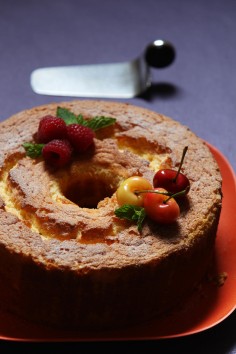
Dessert recipes: orange chiffon cake, and sour cream coffee cake
Impress friends by serving that afternoon cup of tea with a slice of something light, luscious and easy to make.

This recipe comes from the book by Rose Levy Beranbaum. The only things I have changed are that instead of using all orange juice, I use some lemon juice, so the cake is less sweet; and I add a lot more zest than she instructs.
You need a two-piece 25cm tube pan for this cake. Do not grease and flour it or spray it with pan-coating. You also need a large wire balloon whisk, for mixing the whipped egg whites into the batter (the whisk maintains the volume of the whites better than a spatula would).
Preheat the oven to 160 degrees Celsius.
Put the flour, 270 grams of sugar, the baking powder and salt in a large mixing bowl and stir thoroughly. Add the oil, egg yolks, orange and lemon juices, and orange and lemon zest and beat until smooth.
Put the egg whites into a large, clean, dry mixing bowl. Use an electric mixer fitted with clean, dry beaters to whip the egg whites until frothy. Add the cream of tartar and whip until the whites form soft peaks. Mix in 30 grams of sugar and whip until the egg whites form medium-stiff peaks.
Stir a quarter of the egg whites into the flour/sugar/egg mixture. Add the remaining whites in two additions, gently stirring them in with a balloon whisk until the colour is evenly very pale orange. Pour the batter into the ungreased tube pan and bake at 160 degrees for 45 minutes. Very carefully turn the cake around in the oven so it bakes evenly; it's fragile at this point, so move it gently. Continue to bake the cake until it's done: it should be brown and fragrant, and when you touch the surface it should be firm. Check by inserting a wooden skewer into the cake, near the inner tube - the skewer should come out clean. When the cake is ready, immediately invert it, placing the inner tube over the neck of a wine bottle; cooling it upside down keeps the structure of the delicate cake, so it remains light. Leave it until it's completely cool. Carefully run a small flexible spatula around the pan and inner core, to loosen the cake from the metal, then transfer the cake to a serving dish. Dust it lightly with icing sugar, then slice it with a serrated knife. Serve with whipped cream and fresh fruit, if desired.
This is my mother's recipe. She called it "coffee cake" because it goes well with a cup of coffee, although it's just as delicious with tea.
I usually bake it in one or two bundt cake pans, but you can also use a 20-23cm tube pan.
Preheat the oven to 180 degrees. Spray the bundt or tube pan with pan coating.
Put the butter, sugar, baking powder, baking soda and salt in a mixing bowl and beat the ingredients until they're light and fluffy. In a mixing cup, whisk the eggs with the vanilla extract. Add half the eggs to the butter/sugar and stir to combine, then add the rest. (The mixture might look curdled - that's fine.) Scrape the mixing bowl and the beaters with a rubber spatula, then stir in the sour cream. Add the flour and mix on low speed until just incorporated. Scrape the mixing bowl and beaters, and stir again.
Mix together the ingredients for the topping.
Pour slightly less than half of the cake batter into the prepared pan and sprinkle with half of the topping ingredients. Spoon the remaining batter into the pan, taking care not to disturb the topping layer. Sprinkle with the remaining topping ingredients. Bake the cake at 180 degrees for about 20 minutes, then turn it around in the oven and continue baking until done. It's ready when it's fragrant and brown, and firm to the touch. Cool the cake completely, then invert it onto the serving platter and remove the pan.

